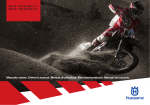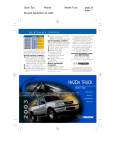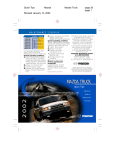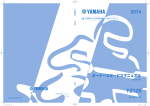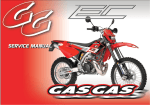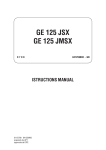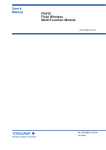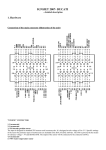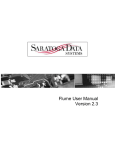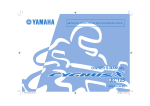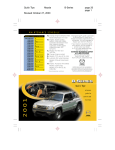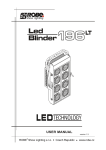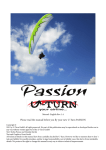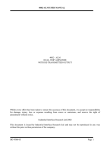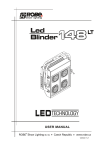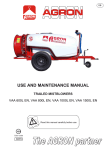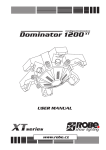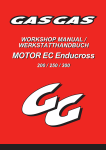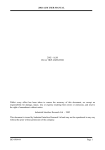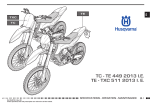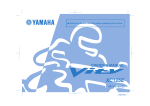Download WR 250
Transcript
WR 250 - WR 250 USA 2013 WR 300 - WR 300 USA 2013 Manuale utente_Owner’s manual_Manuel d’utilisateur_Benutzerhandbuch_Manual del usuario EN WR 250 WR 300 WR 250 - WR 250 USA 2013 WR 300 - WR 300 USA 2013 Ed. 05-2012 - Rev. 00 Unless specified, data and prescription are referred to all the models. SPECIFICATIONS - OPERATION - MAINTENANCE EN- 1 TABLE OF CONTENTS Page PRESENTATION........................................................................ 3 IMPORTANT NOTICES............................................................... 3 IDENTIFICATION DATA. ............................................................ 5 control location.................................................................6 TECHNICAL DATA..................................................................... 7 LUBRICATION TABLE, SUPPLIES................................................ 8 CONTROLS. ............................................................................. 9 RIDING................................................................................. 16 APPENDIX............................................................................. 45 PRE-DELIVERY INSPECTION. ................................................... 47 ALPHABETICAL INDEX. ........................................................... 48 PERIODIC MAINTENANCE -ADJUSTMENT.................... APPENDIX A Note •References to the “left” or “right” of the motorcycle are in the sense of a person facing forwards. •Z: •A: AUS: B: BR: CDN: CH: D: E: F: FIN: GB: I: J: USA: number of teeth Austria Australia Belgium Brazil Canada Switzerland Germany Spain France Finland Great Britain Italy Japan United States of America •Where not specified, all the data and the instructions are referred to any and all Countries. EN - 2 SPECIFICATIONS - OPERATION - MAINTENANCE IMPORTANT NOTICES WR are STREET LEGAL motorcycles (with LIMITED POWER ENGINE); they are guaranteed exempt from functional defects and covered with legal guarantee, if the STANDARD CONFIGURATION is maintained and the suggested maintenance table, shown on Appendix A is observed. If WR are transformed in COMPETITION MOTORCYCLES (with FULL POWER ENGINE), the suggested maintenance table for competition use is shown on Appendix A. WR 250 ENDURO EN PRESENTATION Welcome to the Husqvarna motorcycling Family! Your new Husqvarna motorcycle is designed and manufactured to be the finest in its field. The instructions in this book have been prepared to provide a simple and understandable guide for your motorcycle’s operation and care. Follow the instructions carefully to obtain maximum performance and your personal motorcycling pleasure. Your owner’s manual contains instructions for owner care and maintenance. The main work of repair or maintenance requires the attention of a skilled mechanic and the use of special tools and equipment. Your Husqvarna dealer has the facilities, experience and original parts necessary to properly render this valuable service. This “Owner’s Manual” is part and parcel of the motorcycle, hence, this had to remain with the motorcycle even when sold to another user. This motorcycle uses components designed thanks to systems and state of the art technologies which are thereafter tested in competition. In competition motorcycles, every detail is verified after each race in order to always guarantee better performance. For correct functioning of the vehicle, it is necessary to follow the maintenance and control table found on Appendix A. WR 300 SPECIFICATIONS - OPERATION - MAINTENANCE EN- 3 IMPORTANT The reference for recognition of the guarantee will be the MOTORCYCLE CONFIGURATION, as shown below: A) STANDARD MOTORCYCLE, STREET LEGAL: with LIMITED POWER ENGINE B)COMPETITION MOTORCYCLE, RACING USE: with FULL POWER ENGINE This motorcycles was not designed for long trips with the engine always at maximum rpm as can occur whilst travelling on roads or highways. Long trips at full throttle can cause severe damage to the engine. This motorcycles was not designed for urban use and is not equiped with a cooling fan and thermostat. Long stops at the traffic lights can cause overheating and the boiling of radiator water. This motorcycles is setup for competition use and therefore guarantees maximum performance with the rider alone. It is thereby not recommended to use the vehicle on circuits or off-road with a passenger. Important Notice Read this manual carefully and pay special attention to statements preceeded by the following words: WARNING*: Indicates a possibility of severe personal injury or loss of life if instructions are not followed. CAUTION*: Indicates a possibility of personal injury or equipment damage if instructions are not followed. Note*: Gives helpful information. Parts Replacement When parts replacement is required, use only Husqvarna ORIGINAL parts. In order to maintain the vehicle’s “Guarantee of Functionality”, the client must follow the maintenance program indicated in the user’s manual by carrying out maintenance checks at authorized HUSQVARNA dealers. The cost for substituting parts and for the labour necessary in order to respect the maintenance plan, is charged to the client. NOTE: the guarantee is EXTINGUISHED in the case where the motorcycle is rented. EN - 4 SPECIFICATIONS - OPERATION - MAINTENANCE WARNING*: After an upset, inspect the motorcycle carefully. Make sure that the throttle, brake, clutch and all other systems are undamaged. Riding with a damaged motorcycle can lead to a serious crash. WARNING*: Never attempt to start or operate your motorcycle unless you are wearing appropriate protective clothing. Always wear a motorcycle helmet, motorcycle boots, gloves, goggles and other appropriate protective clothing. WARNING*: Do not attempt to start or ride this motorcycle until you have received expert instruction and are in excellent physical condition. PRECAUTIONS FOR CHILDREN WARNING •Park the vehicle where it is unlikely to be bumped into or damaged. Even slight or involuntary bumps can cause the vehicle to topple over, with subsequent risk of serious harm to people or children. •To prevent the vehicle from tipping over, never park it on soft or uneven ground, nor on asphalt strongly heated by the sun. •Engine and exhaust pipes become very hot during riding. Always park your motorcycle where people or children can not easily reach these parts, in order to avoid serious burns. IDENTIFICATION DATA The engine number is printed on the upper side of the engine case, whereas the frame number is printed on the steering tube. Always state the number stamped on the frame (and write it on this booklet), when placing orders for spare parts, or when asking for information on your motorcycle. EN 1 FRAME NUMBER 2 VEHICLE IDENTIFICATION NUMBER (V.I.N.) The full 17 digit serial, or Vehicle Identification Number, is stamped on the steering head tube (R.H. side). (l) = Model designation (▲) = Model Year (2013) (♦) = Progressive no. WR 250 1. Frame serial number 2. Engine serial number WR 300 ZKH3H02ABDV000001 (l) (▲) (♦) ZKH3H02ACDV000001 (l) (▲) (♦) SPECIFICATIONS - OPERATION - MAINTENANCE EN- 5 control location 1. Front brake lever 2. Throttle grip 3. L.H. commutator 4. Rear brake control pedal 5. Starting pedal 6. Clutch control lever 7. Fuel tank filler cap 8. Gearbox control pedal 9. Choke (L.H. side) 10. Fuel cock 2 7 6 1 10 4 9 8 EN - 6 3 SPECIFICATIONS - OPERATION - MAINTENANCE 5 (with closed ports) WR 250...............................................8,4:1 (with closed ports) WR 300...............................................6,9:1 Starting .................................................................. kick start TIMING SYSTEM Type..................................................lamellar valve on suction H.T.S. valve with mechanical control on the exhaust LUBRICATION Engine........................................... 3% (1:32) of oil-gasoline mix during running in; NOT LESS than 2% (1:50) when running in is over Primary drive transmission/Gearbox.by the oil contained in the crankcase IGNITION Type................................. electronic digital capacitor-discharge type, with variable advance Spark plug type......................................................NGK BR8EG Gap....................................0.0236÷0.0275 in. (0,6 ÷ 0,7 mm) FUEL SYSTEM Type........................................... Carburettor “Mikuni” TMX 38 Venturi diameter............................................1.49 in. (38 mm) High speed jet.....................................................................380 High speed jet (250 USA)....................................................430 High speed jet (300 USA)....................................................420 Low speed jet.....................................................................17,5 Low speed jet (250 USA).......................................................40 Low speed jet (300 USA).......................................................35 Starting jet............................................................................80 Main nozzle...............................................................R-8 (914) Floater (n° 2)...................................................................g 6,1 Throttle piston......................................................................5,0 Throttle piston (USA)............................................................4,0 Metering pin............................................................ 6BFY43-74 Metering pin (300 USA)...........................................6GAY69-74 Metering pin slot..................................................................3^ Idle mixture adjusting screw............................................ 1 + ½ PRIMARY DRIVE Drive pinion gear- Clutch ring gear ........................... Z 27- Z 69 Transmission ratio . .........................................................2,555 CLUTCH Type....... oil bath multiple disc clutch, mechanical control TRANSMISSION Type......................................... constant mesh gear type Transmission ratio 1st gear. .......................................................2,142 (z 30/14) 2nd gear.......................................................1,750 (z 28/16) 3rd gear. ......................................................1,437 (z 23/16) 4th gear........................................................1,210 (z 23/19) 5 th gear. .....................................................1,053 (z 20/19) FINAL RATIOS 1st gear.........................................................................20,220 2nd gear........................................................................16,513 3rd gear........................................................................13,564 4th gear.........................................................................11,422 5th gear...........................................................................9,932 FRAME Type................................ Steel single tube cradle (roud tubes); light alloy rear frame. FRONT SUSPENSION Type....................”Upside-down” telescopic hydraulic front fork with advanced axle (adjustable in compression and rebound stroke); stanchions tubes Ø 1.89 in (48 mm). Legs axis stroke........................................11.8 in. (300 mm) REAR SUSPENSION Type...............progressive with hydraulic single shock absorber Wheel stroke.............................................12.6 in. (320 mm) FRONT BRAKE Type............fixed disc Ø 10.23 in. (260 mm) “Wave” type with hydraulic control and floating caliper REAR BRAKE Type.....................................floating disc, ø 8.66 in. (220 mm) with hydraulic control and floating caliper SECONDARY DRIVE Transmission sprocket- Rear wheel sprocket............... Z 13- Z 48 Transmission ratio............................................................3,692 SPECIFICATIONS - OPERATION - MAINTENANCE EN- 7 EN TECHNICAL DATA ENGINE Type............................................... single cylinder, 2 stroke Cooling. ........................................................................ liquid Bore (250)..................................................2.61 in (66,4 mm) Bore (300).....................................................2.83 in (72 mm) Stroke. ..........................................................2.83 in (72 mm) Displacement (250).....................15.21 cu. in. (249,3 cm3) Displacement (300)..................... 17.87 cu. in. (293,1 cm3) Compression ratio RIMS Front...................................................... in light alloy: 1,6x21” Rear.....................................................in light alloy: 2,15x18” TYRES Front...................................................................... 90/90x21” Rear................................................................... 140/80x18” Cold tire pressure (front) (*)..........................................................12.8÷14.2 psi ( front) (%)..................................................................15.6 psi rider and passenger (rear) (*)............................................................11.4÷12.8 psi (rear) (%)....................................................................14.2 psi (*) Racing use - (%) Road use DIMENSION, WEIGHT, CAPACITY Wheelbase ............................................... .57.7in. (1465 mm) Overall length......................................... 87.79 in. (2230 mm) Overall length (USA-CDN)............................. 86 in. (2185 mm) Overall width............................................ 33.07 in. (840 mm) Overall height .......................................... 51.8 in. (1310 mm) Saddle height ............................................ 38.4 in. (975 mm) Minimum ground clearance . ................... 13.58 in. (345 mm ) Kerb weight, without fuel..............................227.1 lb (103 kg) Kerb weight, without fuel (USA-CDN).............224.4 lb (102 kg) Fuel tank capacity, 1.77 Imp. Quarts - 2.1 U.S. Quarts reserve included . ..................... 2.09 Imp. Gall. , 2.51 U.S. Gall. Coolant capacity.................................. 0.97÷1.14 Imp. Quarts , .............................................................1.16÷1.37 U.S. Quarts Transmission oil................. 0.70 Imp. Quarts , 0.85 U.S. Quarts EN - 8 TABLE FOR LUBRICATION, SUPPLIES Engine lubricating oil CASTROL A747 Gearbox and primary drive lubricating oil CASTROL POWER 1 RACING 10W-40 Engine coolant CASTROL MOTORCYCLE COOLANT Brake system fluid CASTROL RESPONSE SUPER DOT 4 Grease lubrication CASTROL PASTE TA GREASE Final drive chain lubrication CASTROL CHAIN LUBE RACING Front fork oil Kayaba KHL15-11 Oil for rear shock absorber TITAN SAF 5045 UE 137 RED Electric contact protection CASTROL METAL PARTS CLEANER CASTROL MOTORCYCLE DWF Fillers for radiator AREXONS TURAFALLE LIQUIDO SPECIFICATIONS - OPERATION - MAINTENANCE FUEL SUPPLY VALVES The cock (1) set on left side of tank has three positions: OFF - closed; no fuel outlet; ON - open; fuel outflows from the main flow; RES - reserve; fuel outflows from the reserve flow. When running, should feed problem ensue, set cock lever on RES position. After filling up, take the cock in ON position again. A fuel filter is incorporated in the fuel valves. Accumulation of dirt in the filter will restrict the flow of the fuel to the carburetor. Therefore, the fuel filter should be serviced periodically. To service: 1- Drain the fuel from the fuel tank. Disconnect the fuel line. 2- Remove the fuel valve by removing the screws. Wash the fuel screen filter in cleaning solvent. 3- Reassemble the fuel valve in the reverse order of removal. Turn the fuel valve “ON” and check for leaks. WARNING*: Be careful not to touch the hot engine while operating the fuel valve. SIDESTAND A sidestand (1) is supplied with every motorcycle. WARNING*: The stand is designed to support the weight of the MOTORCYCLE ONLY. Do not sit on the motorcycle using the stand for support as this could cause structural failure to the stand and could cause serious bodily injury. Periodically check the side stand (see “Periodical maintenance card”); check that the springs are not damaged and that the side stand freely moves. If the side stand is noisy, lubricate the fastening pivot (A). 1. Fuel cock A. To carburettor SPECIFICATIONS - OPERATION - MAINTENANCE EN- 9 EN CONTROLS FUEL The motorcycle is equipped with 2 stroke engine that requires a gasoline-oil mixture. Recommended fuel: premium grade unleaded fuel (R.O.N. 98). Note*: Do not continue operation if the engine pings or knocks. The engine will be damaged and could seize. CARBURETOR CHOKE The starter knob (1), located on the left side of the carburetor, is used to enrich the mixture during the engine start. Pull out the knob to open the starter, and pull the lever upwards to close it. WARNING*: If “knocking” or “pinging” occurs, try a different brand of gasoline or higher octane grade. WARNING*: Gasoline is extremely flammable and can be explosive under certain conditions. Always stop the engine and do not smoke or allow flames or sparks in the area where the motorcycle is refueled or gasoline is stored. WARNING*: Do not overfill the tank. After refueling, make sure the tank cap (2) is closed securely. 2 EN - 10 SPECIFICATIONS - OPERATION - MAINTENANCE - The instrument functions are the following, as shown below. 1- SPEED (Km/h or mph) / ODO The motorcycle is equipped with a digital instrument; on the instrument are located 2 warning lights too: high beam and blinkers. 1- SPEED / ODO 2- SPEED / CLOCK 3- SPEED / TRIP 4- SPEED / CHRONO 1- SPEED / ODO ................. - SPEED: motorcycle speed- maximum value: 299 Km/h or 299 mph; - ODO: odometer- maximum value: 99999 km; 1- BLUE warning light “HIGH BEAM” 2- GREEN warning light “BLINKERS” The instrument display illuminates (amber colour) when the engine started. NOTES - Every time the engine starts, for the first 2 seconds, the instrument shows the version of the checking SW; after the check, the instrument shows the last planned function. - When the motorcycle engine is OFF, the instrument doesn’t also show its functions. - To select the instrument functions and to set to zero the functions, use the SCROLL knob (A). To replace kilometers with miles or miles with kilometers proceed as follows: 1)set to figure 1, stop the engine and push the knob SCROLL (A); 2)Start the engine holding pushed the button SCROLL (A) until the symbol “Km/h” will be displayed; 3)then the symbols “Km/h” and “Mph Miles” will be displayed alternatively. Push again the SCROLL (A) button when the unit you wish to use is displayed. SPECIFICATIONS - OPERATION - MAINTENANCE EN- 11 EN DIGITAL INSTRUMENT, WARNING LIGHTS 2- SPEED / CLOCK 3- SPEED / TRIP 1 4- SPEED / CHRONO (STP) - SPEED: motorcycle speedmaximum value: 299 Km/h o 299 mph; - CLOCK: clock- Reading from 0:00 to 23:59:59; To reset the clock, push the knob SCROLL (A) for more than 3 seconds in order to increase the hours; release the knob and then, after 3 seconds, it is possible to increase the minutes; - SPEED: motorcycle speedmaximum value: 299 Km/h o 299 mph - TRIP 1: distance- maximum value: 999.9 km (the data will be lost with voltage lower than 6V). To setup the TRIP, push the SCROLL (A) button holding down more than 3 seconds. - SPEED: motorcycle speedmaximum value: 299 Km/h o 299 mph; - STP 1: miles/kilometers covered time; - Reading from 0:00 to 99:59:59 (the data will be lost with voltage lower than 6V). To activate the function STP 1, push the knob SCROLL (A) for more than 3 seconds. - 1st step: function ON; - 2nd step: stop to the counters; - 3rd step: STP 1 zero-setting; TRIP 1 and AVS 1 data zerosetting; - 4th step: function ON; - 5th step: stop to the counters; ............................. and so following EN - 12 SPECIFICATIONS - OPERATION - MAINTENANCE STEERING LOCK The throttle knob (1), is located on the right hand side of the handlebar. The position of the throttle control can be adjusted by loosening the two fastenig screws . The motorcycle is equipped with a steering lock (1) on the R.H. side of the steering head tube. To lock it, procede as follows: turn the handlebar leftwards, place the key in lock and turn counterclockwise. Push the key inwards (if necessary, turn to and from). Turn the key clockwise and remove it from the lock. To unlock the steering lock, reverse the above procedure. CAUTION Do not forget to tighten the screws (A) after the adjustment. FRONT BRAKE CONTROL The brake control lever (2) is located on the right hand side of the handlebar. The position of the throttle control can be adjusted by loosening the two fastenig screws (B). CAUTION Do not forget to tighten the screws (B) after the adjustment. 1 SPECIFICATIONS - OPERATION - MAINTENANCE EN- 13 EN THROTTLE CONTROL HANDLEBAR COMMUTATOR 1) Engine stop button ( CLUTCH CONTROL The clutch lever is located on the left-hand side of the handlebar and is protected against dirt filtering in. The lever support is provided with adjusting screw (1) to regulate clutch wire free play. The clutch lever can be adjusted to suit your driving position. ) ) Selection control High beam 2) HI = ( ) Selection control of Low beam LO = ( 3) TURN = Activation of left turn indicators (self cancelling) = Activation of right turn indicators (self cancelling) To deactivate the indicator, press the control lever after its returning to center. ) Warning horn 4) HORN = ( 5) LIGHTS = Lighting control of lowbeams and high beam. = Lighting control of position lights. 5 4 1 2 3 = Off USA ENGINE STOP BUTTON (USA) 1 On the left side of the handlebar, near the clutch control, is located the engine stop button (1). EN - 14 SPECIFICATIONS - OPERATION - MAINTENANCE CAUTION Do not forget to tighten the screws (C) after the adjustment. A: To decrease clearance B: To increase clearance GEAR SHIFT CONTROL The rear brake control (1) is placed on the right-hand side of the motorcycle. On models TE and SMR as stop switch, during the braking action, causes the rear light to come on. The lever (1) is placed on the left-hand side of the engine. The operator must release the lever after each gear change to allow it to return to its central position before another gear change can be made. Neutral position (N) is between first (low) and second gears. First gear is engaged by pushing the lever downwards; all the other gears are engaged, by pushing the lever upwards. The position of the gear shift lever on the shaft can be varied by: loosening screw; pulling lever out; placing lever in new position on the shaft when the operation is over tighten the screw and then tightening the screw. KICKSTART PEDAL The kickstart pedal (1) is situated on the right-hand side of the motorcycle. EN REAR BRAKE CONTROL CAUTION*: Do not shift gears without disengaging the clutch and closing the throttle. The engine could be damaged by “overspeed” and shock. WARNING*: Do not downshift when traveling at a speed that would force the engine to overrev in the next lower gear, or cause the rear wheel to lose traction. N: Neutral 1 2 SPECIFICATIONS - OPERATION - MAINTENANCE EN- 15 RIDING BEFORE EVERY RIDE MAKE FOLLOWING CHECKS WARNING! Before each ride, to prevent accidents or failures during ride, make sure to go through following list. 1. Check all fluids A. Transmission oil level B. fuel level C. coolant level Make sure all caps are properly adjusted. WARNING*: Don’t remove radiator cap when hot! 2.Check all controls A. Throttle handgrip B. Clutch lever Make sure cables are not damaged and turn smoothly. 3.Check brakes Look for brake fluid leaks and worn hoses. Check for proper functioning. 4.Check suspensions Compress fork and rear suspensions. Look for oil leaks and ensure proper functioning. 5.Check wheels Check spokes and look for worn bearings. Check rims and tyres. Check tyre pressure. 6.Check chain rollers and sprockets Check wear on chain rollers and sprockets Ensure chain is correctly adjusted and lubricated. 7.Check air filter and intake system Check that air filter is clean Check all rubber connections and clamps. 8. Check exhaust system Check hook up, look for cracks Check muffler. EN - 16 9. Check torque A. Spark plug. B. General check of torque 10. Check steering action Check bearing play. 11. Check the electric system Start the engine and check that the front and rear lamps, the stop light, the turn signals the cluster warning lights and the horn are working correctly. WARNING*: Failure to perform these checks every day before you ride may result in serous damage or a severe accident. RUNNING IN To obtain the best settling of the engine moving elements, for driving your motorcycle to the best of your capability, run in the engine for several hours, following these procedures: 1. FROM STOP POSITION. Start the engine and run at idle, but open the throttle periodically and briefly until the engine is thoroughly warmed up. Within 3-4 minutes the coolant temperature will have reached approximately 60° C/140° F. (Do not ride the motorcycle). 2. Stop the engine, and let it cool down naturally until its temperature is equal to the ambient air temperature. This will allow the piston to align itself to any imperfections which might exist at the cylinder wall. 3. Repeat steps 1 and 2. (Do not ride the motorcycle). 4. Bring the engine up to normal running temperature. Ride the motorcycle approximately 10 minutes at moderate speeds. Then repeat cool down procedure.AVOID HARD ACCELERATIONS. 5. Bring engine up to normal temperature. Ride motorcycle approximately 15 minutes at moderate to high speeds. Again SPECIFICATIONS - OPERATION - MAINTENANCE avoid hard accelerations. 6.Repeat cool down procedure. 7. Full throttle operation must be avoided until the engine has reached operating temperature, even after the break in process is completed. When the above procedure is followed correctly, engine durability and performance will be greatly enhanced. CHECKS WHILE RUNNING IN When running in, the following should be checked out: - WHEELS SPOKES TENSION; - TIGHTENING OF WHEELS - FORK PIN TIGHTENING - CHAIN ADJUSTMENT; - STEERING BEARING PLAY; - HANDLEBAR TIGHTENING - ENGINE GRIP TO FRAME - SUCTION FITTING GRIP - HEAD AND CYLINDER NUTS GRIP Note*: After break in, install a new spark plug and change the transmission oil. IMPORTANT NOTE IN CASE OF COLD STARTS AT LOW TEMPERATURES It is recommended to briefly warm-up the engine at idle until, after having disengaged the starter, there is a normal response from the engine when opening the throttle. This will enable the lubricant to reach the correct working temperature thereby guaranteeing a correct functioning of all engine parts. Avoid overheating the engine. 1 IMPORTANT Never accelerate the engine after a cold start. WARNING*: Exhaust contains poisonous carbon monoxide gas. Never run the engine in a closed garage or in a confined area. WARNING*: This high performance motorcycle can some times «kick back» strongly when you are starting it. Do not attempt to start this motorcycle unless you are wearing high top heavy sided riding boots. You could seriously hurt you leg if the kickstarter kicked back and your foot slipped. 4 3 SPECIFICATIONS - OPERATION - MAINTENANCE EN- 17 EN ENGINE START For the correct start of a cold engine proceed as follows: - shift the transmission into neutral; - set fuel valve (1) in ON position; - lift the knob lever (3) on the carburetor. Leaving the throttle in closed position operate kick-start (4). Take the knob lever in its initial position as soon as the engine is idling. When starting with an already warmed up engine DO NOT USE the starter. You can start the engine with the gear inserted, after disconnecting of the clutch. If the carburetor is flooded, shut off the fuel supply and the starter and operate the crank lever or the kick-start until the engine starts. If necessary, remove the spark plug and dry it. STOPPING THE MOTORCYCLE AND THE ENGINE - Close the fuel cock (4). - Press the engine stop button (3). When the bike is off, place it on its side stand. - Close the throttle (1) completely so that the engine will help slow down the motorcycle. - For normal braking, gradually apply both front and rear brakes while down shifting (for maximum deceleration, apply the front and rear brakes firmly). - When stopped, pull the clutch lever and shift gear lever (2) in neutral position. 3 1 USA 2 3 EN - 18 SPECIFICATIONS - OPERATION - MAINTENANCE 4 TRANSMISSION OIL CHANGE By keeping the motorcycle on a flat surface and in vertical position, remove the control screw (C), and check the level through the hole in the screw. To completely replace the oil, unscrew the plug (A) under the oil sump and let oil come out, then screw the plug again with its gasket and pour fresh oil from the hole of the loading plug. Use only the prescribed quantity and type of oil. Note*: Have this operation made with warmed-up engine. A: Draining plug B: Filling cap C: Levelling screw Note: Have this operation made with warmed-up engine. A: Draining plug COOLANT LEVEL CHECK Check level (1) in right-hand radiator when engine is cold (place the motorcycle so that it is perpendicular to the ground). The coolant should be approximately 10 mm above cells. The radiator cap is provided of two unlocking positions, the first being for the previous pressure discharge in the cooling system. WARNING Avoid removing radiator cap when engine is hot, as coolant may spout out and cause scalding. NOTE Difficulties may arise in eliminating coolant from varnished surfaces. If this occurs, wash off with water. 1 10 mm (0,39 in.) SPECIFICATIONS - OPERATION - MAINTENANCE EN- 19 EN TRANSMISSION OIL LEVEL CHECKING REPLACEMENT OF COOLING FLUID The cooling liquid replacement must be performed with cold motor, as follows: - remove the R.H. radiator plug; - remove the drain screw (2) on the pump cover or the pump cover by loosening the two screws (1); - slope the motorbike on the left, to make the liquid come out easily; - let the liquid drain completely; - reassemble the drain screw or the pump cover; - pour the necessary quantity of liquid in the radiator; - warm up the motor in order to eliminate any possible air bubble; - fit the motor in vertical position and check that the liquid in the radiators must be 10 mm/0.4 in. over the radiant mas (if not, top it up); - screw the R.H. radiator plug. EN - 20 WARNING*: Coolant on tires will make them slippery and can cause an accident or injury. Periodically check the connecting hoses (see “Periodical maintenance card”): this will avoid coolant leakages and consequent engine seizure: If hoses show cracks, swelling or hardenings due to sheats desiccation, their replacement shall be advisable. Check the correct tightening of the clamps. SPECIFICATIONS - OPERATION - MAINTENANCE The throttle cable can be adjusted using the screw set on the throttle, or using the adjusting screw set on the carburettor cover. To check for proper adjustment of throttle cable, proceed as follows: - remove rubber cap; - move transmission sheath to and fro to ensure a play of approx. 1 mm; - should play be greater than 1 mm, loosen lock nut (1) and register (2); should play less than 1 mm, then tighten lock nut and register; - if register (2) should not provide sufficient movement to allow for correct adjustment, then adjust register placed on carburetor. There should be approx. 1 mm play on latter register; should this not be the case, then loosen lock nut (3), and loosen or tighten screw (4), to respectively increase or decrease the play. IDLING ADJUSTMENT WARNING*: Operation with damaged throttle cable could result in an unsafe riding condition. WARNING*: Exhaust gas contains poisonous carbon monoxide gas. Never run the engine in a closed area or in a confined area. Idling should be adjusted only when the engine is hot and throttle is closed, as follows: - Turn idle speed adjuster screw (1) to reach 1400 ÷ 1500 rpm. - Air adjuster screw (2) standard calibration: from fully closed position, loosen screw by 1+1/2 turns. SPECIFICATIONS - OPERATION - MAINTENANCE EN- 21 EN THROTTLE CABLE ADJUSTMENT CLUTCH ADJUSTMENT The clutch is adjusted by stretching the cable using the adjusting unit positioned on the handlebar. As a rule it is sufficient to operate on the handlebar register to restore the clearance due to the flexible transmission stretch. The control lever must always have an empty stroke (C) (3 mm) before starting clutch disengagement. To adjust this clearance, act on register (2) after taking out rubber cap (1); turn the register in the direction indicated by arrow A to reduce the clearance (C); turn it in the direction indicated by arrow B to increase the clearance. 1. Rubber cap 2.Adjusting screw EN - 22 The adjustment can be also effected with tightener (1) set on the right of the frame. Take care to tighten properly the lock nut. If the clutch slips under load or drags in disengaged position after play has been adjusted, it must be taken apart for inspection. For this operation apply to a Dealer. 1. Adjusting screw 2. Locknut 3. Rubber cap SPECIFICATIONS - OPERATION - MAINTENANCE Use NGK BR8EG spark plug (2); the gap is 0,6÷0,7 in. A wider gap may cause difficulties in starting engine and in overloading coil. A gap that is too narrow may cause difficulties when accelerating, when idling the engine or when performing at low speeds. Clean the dirt away from the base of the spark plug before removing it from the cylinder after removing the cap (1). It is very useful to examine the state of the spark plug just after it has been removed from the engine since the deposits on the plug and the colour of the insulator provide useful indications. Correct heat rating: The tip of the insulator should be dry and the colour should be light brown or grey. High heat rating: In this case, the insulator tip is dry and covered with dark deposits. Low heat rating: In this case, the spark plug is overheated and insulator tip is vitreous, white or grey in colour. CAUTION*: Select a spark plug with a colder or hotter heat range carefully and cautiously. A spark plug with too hot a heat range may lead to preignition and possible engine damage. A spark plug with too cold a heat range may foul as the result of too much carbon buildup. Before refitting the plug, thoroughly clean the electrodes and the insulator using a brass-metal brush. Apply a little graphite grease to the spark plug thread; fit and screw the spark plug by hand then tighten to the torque of 23,5÷25,5 Nm- 17,3÷18,8 ft/lb. Spark plugs which have cracked insulators or corroded electrodes should be replaced. 2 SPECIFICATIONS - OPERATION - MAINTENANCE EN- 23 EN SPARK PLUG CHECK AIR FILTER CHECK AIR FILTER AND CLEANING ASSEMBLY Turn rear pin (1) counterclockwise, remove the saddle from the front afstening screw. Wash the filter with a specific detergent (CASTROL FOAM AIR FILTER CLEANER or similar) then dry it fully (wash filter with gasoline only in case of necessity). Plunge the filter in special oil for filters (CASTROL FOAM AIR FILTER OIL or similar) then wring it to drain superfluous oil. To ensure tight fit, slightly (C) grease filter edge on side facing filter housing. While re-inserting the filter into its housing, make surs that piece (A) is turned upwards and edge (B) is on the left lower side of the filter case. Reassemble the parts previously removed (battery: connect the positive cable first). Remove screw (3) and the filter (4). Separate filter (5) from frame (6). CAUTION*: Do not use gasoline or a low flashpoint solvent to clean the element. A fire or explosion could result. CAUTION*: Clean the element in a well ventilated area, and do not allow sparks or flames anywhere near the working area. CAUTION*: If the element assembly is not installed correctly, dirt and dust may enter and the engine resulting in rapid wear of the piston rings and cylinder. 1 3 EN - 24 A 6 4 5 SPECIFICATIONS - OPERATION - MAINTENANCE C B To ensure maximum safety, the steering wheel should always be regulated so that the handlebars steering the motorcycle rotate freely without play. To check steering wheel adjustment, place kick stand or other support under the engine so that the front wheel is raised from ground. Place slight pressure on the tips of the handlebars to rotate steering wheel; the handlebars should also rotate without effort. Stand in front of the motorcycle and grasp the lower end of the fork rods sliders moving them in the direction of their axis. Se si avverte gioco occorrerà eseguire la regolazione operando come segue: - loosen steering sleeve nut (1). -Loosen screws that fix steering head to fork rods (3). Turn the steering ring nut (2) clockwise of the steering sleeve proper tool, to adjust play properly. - Tighten steering sleeve nut (1) to a torque setting of 57,9÷65,1 Lb/ft; (78,4÷88,3 Nm). - Tighten screws on the steering head (3) to a torque of 22,5÷26,5 Nm (16.6÷19.5 Lb/ft). CAUTION*: Do not ride a motorcycle with damaged steering stem bearings. An unsafe handling condition can result. 1 3 2 SPECIFICATIONS - OPERATION - MAINTENANCE EN- 25 EN STEERING WHEEL BALL PLAY ADJUSTMENT ADJUSTMENT OF THE CONTROL LEVER AND CHECK OF THE FRONT BRAKE FLUID LEVEL A decrease of the fuel level will let air into the sustem, hence an extension of the level stroke. The adjuster (2), located on the control lever, allows adjusting of the free play (a). Free play (a) must be at least 3 mm (0.1 in.). The level of the fluid in pump reservoir must never be below the minimum value (1), which can be checked from the window on the rear side of the pump body. WARNING*: If the brake lever feels mushy when it is applied, there may be air in the brake lines or the brake may be defective. Since it is dangerous to operate the motorcycle under such conditions, have the brake checked immediately by an authorized HUSQVARNA dealer. CAUTION*: Do not spill brake fluid on to any painted surface or lenses. CAUTION*:Do not mix two brands of fluid. Change the brake fluid in the brake line if you wish to switch to another fluid brand. CAUTION*: Brake fluid may cause irritation. Avoid contact with skin or eyes. In case of contact, flush thoroughly with water and call a doctor if your eyes were exposed. A: to encrease clearance B: to decrease clearance 1 + B EN - 26 SPECIFICATIONS - OPERATION - MAINTENANCE - 2 A Rear brake idle stroke adjustment CHECKING THE FLUID LEVEL The position of the rear foot brake pedal as to the footrest may be adjusted according to the individual needs. For the adjusting proceed as follows: - loosen the screw (1); - turn the cam (2) in order to adjust the brake pedal idle stroke (A); - the operation done, tighten the screw (1). The rear brake foot pedal should have a (B) 5 mm (0.2 in.) idle stroke before starting the true braking action. The level (A) must be set between the pump tank notches. The adjusting operation carried out, adjust the idle stroke of the pedal as follows. WARNING When the idle stroke figures are not met, the brake pads will be subjected to a fast wear that may bring to the TOTAL BRAKE INEFFECTIVENESS. Should this not happen, operate as follows: - loosen nut (3); - operate the pump rod (4) to increase or decrease the idle stroke; - tighten nut (3) at the end of the operation. SPECIFICATIONS - OPERATION - MAINTENANCE EN- 27 EN REAR BRAKE PEDAL POSITION ADJUSTMENT ADJUSTING THE SUSPENSIONS ACCORDING TO PARTICULAR TRACK CONDITIONS The following information is a useful guide for setting up the suspensions according to the road conditions. Always start from the standard calibration before making any change on the suspensions. Afterwards, increase or decrease the adjusting clicks one at a time. HARD GROUND Fork: softer compression adjustment. Shock absorber: softer compression adjustment. The softer adjustment for the two suspensions is also used both in compression and in extension when driving at top speed, in order to have better grip of the tires. EN - 28 SANDY GROUND Fork: have a harder compression adjustment, or replace the standard spring with a harder one, and make a softer compression adjustment and a harder extension adjustment at the same time. Shock absorber: have a harder compression, and expecially a harder extension adjustment. Work on the spring preload to lower the motorcycle rear side. MUDDY GROUND Fork: have a harder compression adjustment, or replace the standard spring with a harder one. Shock absorber: have a harder compression and extension adjustments, or replace the standard spring with a harder one. Work on the spring preload to lift the motorcycle rear side. We advise replacing the springs of both suspensions to compensate the weight increase due to the piling of the mud. SPECIFICATIONS - OPERATION - MAINTENANCE NOTE: When the fork results as either too soft or too hard for any adjustment conditions, check the oil level inside the forkrod. The level can either be too low or too high. Remember that too much oil inside the fork will involve a more frequent air drainage. When the suspensions do not react to the changes of calibration, check that the adjusting units are not blocked. ADJUSTING THE COMPRESSION FORK a) COMPRESSION (LOWER REGISTER) Standard calibration: -10 clicks . Remove plug (B) and turn register (A) clockwise until the position of fully closed is reached then, turn back by the mentioned clicks.To obtain a smoother braking action, turn the register anticlockwise. Reverse the operation in order to obtain a harder action. c) AIR VENT (to carry out after each competition, or monthly). Set the motorcycle on a central stand and release the fork fully and loosen the air vent valve (D). Once this operation is over, tighten the valve. WARNING: Never force the adjusting screws beyond the maximum opening and closure positions. 643 cm3 NOTE Flexibility index for the serial springs: K=8,4 N/mm To reset standard calibration turn register (C) clockwise to reach the position of fully closed; then, turn back by the mentioned clicks. To obtain a smoother braking action, turn the register anticlockwise. Reverse the operation in order to obtain a harder action. A For the regular fork operation, both legs must be provided with the necessary oil quantity. Remove the forkrods form the fork to check the oil level inside the forkrods. Work as follows: - remove the power rod caps; - remove springs from the stems letting the oil drop into the latter; - bring forks to stroke end; - check that the level is at distance “A” below the upper limit of rods. OIL QUANTITY IN EACH FORK LEG b) EXTENSION (upper register) Standard calibration: - 10 clicks. a) OIL FORK LEVEL NOTE Always replace both the spring and the spacers to keep the preload value unchanged . b) C D SPECIFICATIONS - OPERATION - MAINTENANCE EN- 29 EN The standard calibrations and the adjustment procedures are shown below. ADJUSTING THE SHOCK ABSORBER The rear shock absorber must be adjusted according to the rider weight and track conditions. Proceed as follows: 1. With motorcycle on the stand, measure distance (A). 2. Take the normal riding position on the motorcycle with all your riding apparel. 3. With somebody’s help, take the new distance (A). B: axis of the panel screw C: axis of rear wheel pin 4. The difference between these two measurements constitutes the “SAG” of the motorcycle’s rear end. Suggested SAG: 4 in. with cold shock absorber. 3.7 in. with warmed up shock absorber. 5. To get the right SAG according to your weight, adjust the shock absorber spring preload as described at side. ADJUSTING THE SHOCK ABSORBER SPRING PRELOAD Proceed as follows: 1. First turn counterclockwise fastening rear pin (1) then remove saddle, screws (2) and R.H. side panel (3). WARNING*: Never disassemble shock absorber, which contains highly compressed nitrogen. Contact your Dealer for such major service. Do not incinerate. B 2 A C EN - 30 SPECIFICATIONS - OPERATION - MAINTENANCE 3 SHOCK ABSORBER DAMPING ADJUSTMENT WARNING*:Be careful not to touch hot exhaust pipe while adjusting the shock abosrber. 2) High damping speed: - all open (register 6) To reset the standard calibration, turn upper registers (4) and (6) clockwise until reaching fully closed position. Return then back for the mentioned clicks. In order to obtain a smooth braking action, turn the registers anticlockwise. Reverse Adjustment of the compression stroke is independent from the rebound stroke. A) COMPRESSION - Standard calibration: 1) Low damping speed: - 15 clicks (± 2 clicks) (register 4) B) EXTENSION - Standard calibration: - 15 clicks (± 2 clicks) To reset the standard calibration, turn lower register (5) clockwise until reaching fully closed position. Return then back for the mentioned clicks. In order to obtain a smooth braking action, turn the register anticlockwise. Reverse the operation in order to obtain a harder braking action. the operation in order to obtain a harder braking action. 1 6 3 + 4 5 2 SPECIFICATIONS - OPERATION - MAINTENANCE EN- 31 EN 2. Clean ringnut (1) and adjusting nut (2) of the spring (3). 3. Either with a hook wrench or an aluminium punch, loosen the ringnut. 4. Turn the adjusting nut as required. 5. When the adjusting operation is over (according to your weight and riding style), tighten the ringnut. (Torque for both ringnuts: 5 Kgm; 49 Nm; 36.2 ft/lb). 6. Reassemble R.H. side panel and saddle. CHAIN ADJUSTMENT (Fig. A) Fast adjustment (Fig. B.) Chain should be checked, adjusted and lubricated as per the Maintenance Chart to ensure security and prevent excessive wear. If the chains becomes badly worn or is poorly adjusted (i.e., if it is too loose or too taught), it could escape from sprocket or break. To adjust the rear chain it is necessary to lower the rear part of motorcycle so to line up the drive sprocket axle, the rear swing arm axle and the rear wheel axle as shown on drawing. Than let turn three times the rear wheel. Now the chain should not be tight. Push the chain towards the final part of runner and check that between the two elements a distance “A” from 0 to 2 mm (0,08 in.) is present. If this is not the case, go on as follows: - Unloose the fastening nut of the wheel pin (1) on the right side; - Unloose the lock nuts (2) on both chain adjusters and turn the screws (3) to obtain the correct tension value; - Tighten the lock nuts. After adjustment check that the wheel is lined up and tighten its axle. Fig. A CHECKING THE WEAR OF CHAIN, PINION AND SPROCKET Check the pinion damages or wear and replace it should the wear degree be as the one shown in figure. Remove the wheel and check the wear of the rear sproket teeth. The below figure shows the outline of teeth in normal and excessive wear. Should the sprocket be badly worn out, replace it by loosening the six fastening screws to the hub. WARNING*: Misalignment of the wheel will result in abnormal wear and may result in an unsafe riding condition. Note*: In muddy and wet conditions, mud sticks to the chain and sprockets resulting in an overtight chain. The pinion, the chain, and the rear sprocket wheel wear increases when running on muddy ground. Drive sprocket axle Rear wheel axle Rear swing arm axle Normal consumption Fig. B 3 2 1 EN - 32 SPECIFICATIONS - OPERATION - MAINTENANCE Excessive consumption WARNING * : Never use grease to lubricate the chain. Grease helps to accumulate dust and mud, which act as abrasive and hepl to rapidly wear out the chain, the sprocket, and the crown. Disassembling and cleaning When particularly dirty, remove and clean the chain before lubrication. Work as follows: 1 -Set a stand or a block under the engine and see that the rear wheel is lifted from the ground. Remove: screws (1), transmission sprocket guard (2), clip (3), master link (4) and transmission chain (5); To reassemble, reverse the above procedure. 2 -Check that the chain is neither worn out nor damaged. If the rollers or the links are damaged, replace the chain by following the instructions given in the Periodical Maintenance Table. 3 -Check that neither the sprocket nor the crown are damaged. 4 -Wash and clean the chain as described hereunder. 3 6- Correctly adjust chain, as described in the relevant paragraph. WARNING: The chain oil has NEVER to get in contact with the tires or the rear brake disk. Lubricating the chain with OR Lubricate all metallic and rubber (OR) elements using a brush, and use engine oil with SAE 80-90 viscosity for the internal and external parts. Note * : As an alternative, you can use suitable spray lubricants. Chain tension rollers, chain driving roller, chain guide, chain runner Check the wear of the above mentioned elements and replace them when necessary. WARNING*: Check the chain guide alignement, and remember that a bent element can cause a rapid wear of the chain. In this case, a chain fleeting from the sprocket may ensue. 5 - Assemble the joint spring (a) by turning the closed side to the chain direction of rotation as shown in figure below. NOTE*: Even if all the joints are reusable when in good conditions, for safety purposes we advise using new joints when reassembling the chain. C X 2 4 5 Washing the chain with OR Wash using oil, diesel oil, or paraffin oil. Never use gasoline, tricloroetilene, or solvents, as the OR may suffer damages. Use instead special sprays for chains with OR. 1 A- Chain tension roller B- Chain guide C- Chain slider X- Joint spring B A SPECIFICATIONS - OPERATION - MAINTENANCE EN- 33 EN LUBRICATING THE CHAIN Lubricate the chain following these instructions. Removing the front wheel Set a stand or a block under the engine and see that the front wheel is lifted from the ground. Loosen the bolts (1) holding the wheel axle (2) to the front fork stanchions. Hold the head of the wheel axle (2) in place, unscrew the bolt (3) on the opposite side; draw the wheel axle out. NOTES Do not operate the front brake lever when the wheel has been removed; this causes the caliper piston to move outwards. After removal, lay down the wheel with brake disc on top. 1 2 EN - 34 SPECIFICATIONS - OPERATION - MAINTENANCE 1 3 Fit the L.H. spacer (A) on the wheel hub. Fit the wheel between the front fork legs so that the brake disc is fitted into the caliper. Fit the wheel axle (2) from the R.H. side, after greasing it and push it to the stop on the L.H. leg; during this operation, the wheel should be turned. Tighten the screw (3) on the fork L.H. side but DO NOT lock it. Now, pump for a while, pushing the handlebar downwards until you are sure that the fork legs are perfectly aligned. Lock: the screws (1) on the R.H. leg (10,4 Nm/ 1,05 Kgm/ 7.7 ft-lb), the screw (3) on the L.H. side (51,45 Nm/ 5,25 Kgm/ 38 ft-lb), the screws (1) on the L.H. leg (10,4 Nm/ 1,05 Kgm/ 7.7 ft-lb). NOTE After reassembly, pump the brake control lever until the pads are against the brake disc. A 1 1 2 3 SPECIFICATIONS - OPERATION - MAINTENANCE EN- 35 EN Reassembling the front wheel Removing the rear wheel Unscrew the nut (1) of the wheel pin (3) and extract it. It is not necessary to unloose the chain adjusters (2); in this way, the chain tension will remain unchanged after the reassembly. Extract the complete rear wheel, by taking care of the spacers located at the hub sides. To reassemble, reverse the above procedure remembering to insert the disc into the caliper. NOTES Do not operate the rear brake pedal when the wheel has been removed; this causes the caliper piston to move outwards. After removal, lay down the wheel with brake disc on top. After reassembly, pump the brake control pedal until the pads are against the brake disc. Tightening torque figures 1= 142.1 Nm, 14.5 Kgm, 104.8 ft/lb 2 1 EN3-636 SPECIFICATIONS - OPERATION - MAINTENANCE 2 3 BRAKES Care should be taken to keep the tyres properly inflated. See “Technical data” chart at the beginning of the manual for correct tyre inflation pressure. The mayor components are brake master cylinder with its lever (front) or pedal (rear), brakeline, caliper assembly and disc. LEGEND 1. Front brake control lever 2. Front brake pump with oil reservoir 3. Front brake hose 4. Front brake caliper 5. Front brake disc 6. Rear brake oil tank 7. Rear brake hose 8. Rear brake caliper 9. Rear brake disc 10. Rear brake pump 11. Rear brake control pedal 5 2 EN TIRES 3 3 1 4 7 8 9 10 11 6 SPECIFICATIONS - OPERATION - MAINTENANCE EN- 37 BRAKE PADS REMOVAL PADS WEAR Inspect pads for wear. Service limit “ A” is: 3,8 mm (0.15 in.). If service limit is exceeded, always replace the pads in pairs. - Remove springs (1). - Remove pins (2). - Remove pads. CAUTION! Don’t operate the brake lever or pedal while removing the pads. REAR FRONT 1 1 2 EN - 38 SPECIFICATIONS - OPERATION - MAINTENANCE 2 FRONT REAR Be careful that no disc brake fluid or any oil gets on brake pads or discs. Clean off any fluid or oil that inadverently gets on the pads or disc with alcohol. Replace the pads with new ones if they cannot be cleaned satisfactorily. WARNING! Do not attempt to ride the motorcycle until the brake lever or pedal are fully effective. Pump the brake lever or pedal until the pads are against the discs. The brake will not function on the first application of the lever or pedal. PADS INSTALLATION - Install new brake pads. - Reassemble the two pins (2) and the springs (1). REAR FRONT 1 1 2 2 SPECIFICATIONS - OPERATION - MAINTENANCE EN- 39 EN PADS CLEANING BRAKE DISC WEAR Measure the thickness of each disc at the point where it has worn the most. Replace the disc if it has worn past the service limit. DISC WARPAGE Measure disc warpage. Service limit for both discs is 0,15 mm (0.006 in.) Replace the disc if warpage is more than service limit. Disc Thickness DISC STANDARD EN - 40 SERVICE LIMIT Front 3 mm 0,12 in. 2,5 mm 0,1 in. Rear 4 mm 0,16 in. 3,5 mm 0,14 in. SPECIFICATIONS - OPERATION - MAINTENANCE DISC CLEANING EN Poor braking can also be caused by oil on the disc. Oil or grease on the disc must be cleaned off with a high flash-point oil free solvent, such as acetone or lacquer thinner. SPECIFICATIONS - OPERATION - MAINTENANCE EN- 41 HEADLAMP BULBS REPLACEMENT To gain access to the healamp bulbs, proceede as follows: - remove the upper fastening screw of the the headlamp carrier to the instrument panuel support (1); - push forward the headlamp carrier (B) and pull it towards the high (C) in order to uncouple from the two lower supports. - remove the headlamp carrier; - remove the two filaments bulb connector (2) and the boot (3); - release the bulb holder clips (4) and take out bulb (5); To replace the parking light bulb (6) extract it from the inside cover. After replacement, reverse operations for reassembly. 2 3 1 4 C B 6 EN - 42 SPECIFICATIONS - OPERATION - MAINTENANCE 5 REPLACING THE NUMBER PLATE BULB The tail light (1) is a LED light; Replace it when it does not function. - loosen screw (1) and remove the number plate bulb (2) from the mudguard; - take bulb holder (3) and bulb (4) out of the support; - pull the bulb (4) to detach it from bulb holder. Once the bulb has been replaced, reverse the above procedure to reassemble. 2 1 1 3 4 SPECIFICATIONS - OPERATION - MAINTENANCE EN- 43 EN TAIL LIGHT ADJUSTMENT OF HEADLIGHT When checking the proper orienting of headlight, inflate tires at right pressure, sat a person on the saddle and place the motorcycle perpendicular with its longitudinal axis 10 meter (33 ft) from a wall or screen. Then trace an horizontal line equal to the height of headlight center and a vertical one in line with its longitudinal axis. Adjust the preadlamp aiming by turning screw (1) to lower or lift the high beam. If possibile, execute this operation in a shadowy place. When the low beam is on, the upper boundary limit between dark and lit zone should be 9/10 th of headlight center from groud. 1 EN - 44 SPECIFICATIONS - OPERATION - MAINTENANCE AFTER-RACE CHECK POINTS After racing, first clean the motorcycle and then inspect the entire motorcycle, with special attention to the items listed in «MAINTENANCE» table (Appendix A), such as the air cleaner, carburetor, brakes, etc. Carry out general lubrication, and make adjustment as necessary. STORAGE When the motorcycle is to be stored for any length of time, is should be prepared for storage as follows: - Clean the entire motorcycle thoroughly. - Empty the fuel from the fuel tank, and empty the carburetor float bowl. (If left in for a long time, the fuel will deteriorate). WARNING Never litter the environment with fuel, and let the engine running in open air, never in closed rooms. - Run the engine for about 5 minutes to warm the oil then drain the oil. - Put in fresh transmission oil. - Check all the points listed under the inspection and Adjustment Section (Appendix A). - Lubricate the points (listed in the Lubrication Section (Appendix A). CLEANING IMPORTANT RECOMMENDATION Premised that, before the motorcycle washing, it is necessary to protect opportunely from the water the following parts: a) Rear opening of the muffler; b) Clutch and brake levers, hand grips, handlebar commutators; c) Air cleaner intake; d) Fork head, wheel bearings; e) Rear suspension links. -Lubricate the drive chain and all the cables. - Spray oil on all unpainted metal surfaces to prevent rusting. Avoid getting oil on rubber parts or in the brakes. - Set the motorcycle on a box or stand so that both wheels are raised off the ground. (If this cannot be done, put boards under the front and rear wheels to keep dampness away from the tire rubber). - Tie a plastic bag over the exhaust pipe to prevent moisture from entering. - Put a cover over the motorcycle to keep dust and dirt from collecting on it. To put the motorcycle back into the use after storage. - Make sure the spark plug is tight. - Fill the fuel tank. SPECIFICATIONS - OPERATION - MAINTENANCE EN- 45 EN APPENDIX It is necessary ABSOLUTELY TO AVOID THAT HIGH PRESSURE JETS OF WATER OR AIR come to contact with THE ELECTRICAL PARTS, especially the electronic control unit (1) and the dashboard (2). After washing: - Lubricate the points listed in the Maintenance Table (Appendix A). - Start the engine and run it for 5 minutes. - Test the brakes before riding the motorcycle. WARNING*: Never wax or lubricate the brake disc. Loss of braking and an accident could result. Clean the disc with an oilless solvent such ans acetone. Observe the solvent warnings. 2 1 EN - 46 SPECIFICATIONS - OPERATION - MAINTENANCE After each cleaning, it is recommended the use of a water-repellent product suitable for electrical contacts (see table for lubrications and supplies) on all the electrical contacts, without disconnect them. Trasmissioni e com. fless. Catena di trasmissione Controllo / Regolazione Controllo / Regolazione � � Collaudo generale � PRE-DELIVERY INSPECTION Operation Engine oil Two-stroke mix oil level Coolant Cooling system Electric fans Spark plugs Throttle body / Carburettor Brakes / Clutch fluid Brakes / Clutch Brakes / Clutch Throttle control Throttle control Choke control Flexible controls and transm. Drive chain Check level Check level Check / Restore level Check for leakage Check operation Check / Replace Check and adjust Check level Check operation Check lines for leakage Check operation Check / Adjust play Check operation Check / Adjust Check / Adjust � : presenti solo sui motocicli con motore a 2 tempi �� : presente solo su alcuni modelli Pre-delivery � �� � � ��� � � � � � � � � � � Description Tyres Side stand Side stand switch Electrical equipment Instrument panel Lights / Visual signals Horn Headlight Ignition switch Locks Screws and nuts Hose clamps General lubrication General test Operation Check pressure Check operation Check operation Check operation Check operation Check operation Check operation Check operation Check operation Check operation Check / Tighten Check / Tighten Pre-delivery � � � � � � � � � � � � � � � : only for motorcycles with 2 stroke engine �� : only for some models 279 SPECIFICATIONS - OPERATION - MAINTENANCE EN- 47 EN PRE -DELIVERY INSPECTION Description ALPHABETIC INDEX Page A Adjusting the compression fork........................................................29 Adjusting the shock absorber...........................................................30 Adjusting the shock absorber spring preload....................................30 Adjusting the suspensions according to particular track conditions.......................................................................................28 Adjustment of headlight .................................................................44 Adjustment of the control lever and check of the front brake fluid level ............................................................................26 After-race check points....................................................................45 Air filter check.................................................................................24 Air filter and cleaning.....................................................................24 Appendix........................................................................................45 Assembly........................................................................................24 B Before every ride make following checks.........................................16 Brake disc wear...............................................................................40 Brake pads removal........................................................................38 Brakes............................................................................................37 C Carburetor choke ...........................................................................10 Chain adjustment............................................................................32 Checking the fluid level...................................................................27 Checking the wear of chain, pinion and sprocket.............................32 Checks while running in..................................................................16 Cleaning.........................................................................................45 Clutch adjustment...........................................................................22 Clutch control..................................................................................14 Control location.................................................................................6 Controls............................................................................................9 Coolant level check..........................................................................19 D Digital instrument, warning lights...................................................11 Disc cleaning...................................................................................41 Disc warpage..................................................................................40 EN - 48 E Engine start....................................................................................17 Engine stop button (usa)................................................................14 F Fuel................................................................................................10 Fuel supply valves.............................................................................9 Front brake control.........................................................................13 G Gear shift control............................................................................15 H Handlebar commutator ..................................................................14 Headlamp bulbs replacement..........................................................42 I Identification data.............................................................................5 Idling adjustment............................................................................21 Important notices..............................................................................3 K Kickstart pedal................................................................................15 L Lubricating the chain.......................................................................33 O Oil fork level...................................................................................29 P Pads cleaning..................................................................................39 Pads installation.............................................................................39 Pads wear . ....................................................................................38 Pre-delivery inspection....................................................................47 Presentation......................................................................................3 R Rear brake control..........................................................................15 Rear brake idle stroke adjustment...................................................27 Rear brake pedal position adjustment ............................................27 SPECIFICATIONS - OPERATION - MAINTENANCE Reassembling the front wheel.........................................................35 Removing the front wheel...............................................................34 Removing the rear wheel................................................................36 Replacement of cooling fluid...........................................................20 Replacing the number plate bulb . ..................................................43 Riding.............................................................................................16 Running in......................................................................................16 S Shock absorber damping adjustment...............................................31 Sidestand..........................................................................................9 Spark plug check ...........................................................................23 Steering lock...................................................................................13 Steering wheel ball play adjustment................................................25 Stopping the motorcycle and the engine..........................................18 Storage . ........................................................................................45 T Table for lubrication, supplies............................................................8 Tail light ........................................................................................43 Technical data...................................................................................7 Throttle cable adjustment................................................................21 Throttle control................................................................................13 Tires...............................................................................................37 Transmission oil change..................................................................19 Transmission oil level checking........................................................19

















































